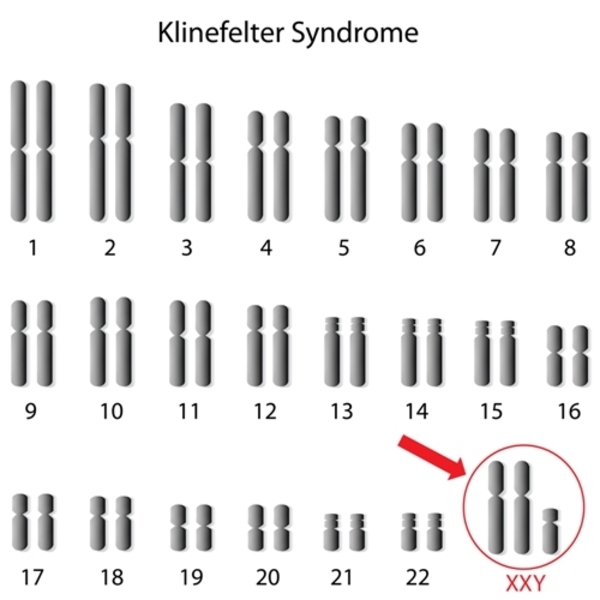Delayed puberty other diagnostic studies: Difference between revisions
Jump to navigation
Jump to search
No edit summary |
m (Bot: Removing from Primary care) |
||
| (11 intermediate revisions by 3 users not shown) | |||
| Line 2: | Line 2: | ||
{{Delayed puberty}} | {{Delayed puberty}} | ||
{{CMG}}; {{AE}}{{EG}} | {{CMG}}; {{AE}}{{EG}} | ||
==Overview== | ==Overview== | ||
[[Karyotyping]] is used to diagnose [[Chromosomal disorder|chromosomal disorders]] in delayed puberty[[Chromosomal disorder|<nowiki/>]], such as [[Turner syndrome]] and [[Klinefelter syndrome]]. University of Pennsylvania Smell Identification Test (UPSIT), consist of microencapsulated odorants released by scratching standardized odor-impregnated questionnaires, is used to detect [[hyposmia]] or [[anosmia]] in [[Kallmann syndrome]]. | |||
==Other Diagnostic Studies== | ==Other Diagnostic Studies== | ||
{| align="right" | |||
| [[image:Monosomy.jpeg|thumb|300px|Karyotyping of Turner syndrome, source: https://www.ghr.nlm.nih.gov/]] | |||
|} | |||
{| align="right" | |||
| [[image:Klinefelter-syndrome-karyotype.jpeg|thumb|300px|Karyotyping of Klinefelter syndrome, source: https://www.ghr.nlm.nih.gov/]] | |||
|} | |||
=== Karyotyping === | === Karyotyping === | ||
* [[Karyotyping]] is the direct visualization of human [[chromosomes]] in a view. | |||
* [[Karyotyping]] is the | * The main syndromes which are the cause of delayed [[puberty]], [[Turner syndrome]], and [[Klinefelter syndrome]] can be diagnosed by [[karyotyping]]. | ||
* The main syndromes which are the cause of delayed [[puberty]], [[Turner syndrome]] and [[Klinefelter syndrome]] can be diagnosed by [[karyotyping]]. | |||
* [[Turner syndrome]] is characterized by one single [[X chromosome]] in females, instead of one pair of [[X chromosomes]].<ref name="urlTurner syndrome - Genetics Home Reference">{{cite web |url=https://ghr.nlm.nih.gov/condition/turner-syndrome |title=Turner syndrome - Genetics Home Reference |format= |work= |accessdate=}}</ref> | * [[Turner syndrome]] is characterized by one single [[X chromosome]] in females, instead of one pair of [[X chromosomes]].<ref name="urlTurner syndrome - Genetics Home Reference">{{cite web |url=https://ghr.nlm.nih.gov/condition/turner-syndrome |title=Turner syndrome - Genetics Home Reference |format= |work= |accessdate=}}</ref> | ||
* [[Klinefelter syndrome]] is characterized by two [[X chromosomes]] along with [[Y chromosome]] in males, instead of one [[X chromosome|X]] and one [[Y chromosome|Y chromosomes]]. | * [[Klinefelter syndrome]] is characterized by two [[X chromosomes]] along with [[Y chromosome]] in males, instead of one [[X chromosome|X]] and one [[Y chromosome|Y chromosomes]].<ref name="urlKlinefelter syndrome - Genetics Home Reference">{{cite web |url=https://ghr.nlm.nih.gov/condition/klinefelter-syndrome |title=Klinefelter syndrome - Genetics Home Reference |format= |work= |accessdate=}}</ref> | ||
=== Olfactory function test === | === Olfactory function test === | ||
* The test, called University of Pennsylvania Smell Identification Test (UPSIT), | * The test, called University of Pennsylvania Smell Identification Test (UPSIT), consists of microencapsulated odorants that released by scratching standardized odor-impregnated questionnaires.<ref name="pmid6694486">{{cite journal |vauthors=Doty RL, Shaman P, Kimmelman CP, Dann MS |title=University of Pennsylvania Smell Identification Test: a rapid quantitative olfactory function test for the clinic |journal=Laryngoscope |volume=94 |issue=2 Pt 1 |pages=176–8 |year=1984 |pmid=6694486 |doi= |url=}}</ref> | ||
* It is used to detect [[hyposmia]] or [[anosmia]] in [[Kallmann syndrome]].<ref name="PalmertDunkel2012">{{cite journal|last1=Palmert|first1=Mark R.|last2=Dunkel|first2=Leo|title=Delayed Puberty|journal=New England Journal of Medicine|volume=366|issue=5|year=2012|pages=443–453|issn=0028-4793|doi=10.1056/NEJMcp1109290}}</ref> | * It is used to detect [[hyposmia]] or [[anosmia]] in [[Kallmann syndrome]].<ref name="PalmertDunkel2012">{{cite journal|last1=Palmert|first1=Mark R.|last2=Dunkel|first2=Leo|title=Delayed Puberty|journal=New England Journal of Medicine|volume=366|issue=5|year=2012|pages=443–453|issn=0028-4793|doi=10.1056/NEJMcp1109290}}</ref> | ||
<br> | |||
<br> | |||
==References== | ==References== | ||
{{reflist|2}} | {{reflist|2}} | ||
| |||
{{WS}} | |||
{{WH}} | |||
[[Category:Disease]] | [[Category:Disease]] | ||
[[Category:Medicine]] | |||
[[Category:Pediatrics]] | |||
[[Category:Endocrinology]] | [[Category:Endocrinology]] | ||
[[Category:Mature chapter]] | |||
[[Category:Developmental biology]] | |||
[[Category:Sexuality and age]] | |||
[[Category:Sexual health]] | |||
[[Category:Growth disorders]] | |||
[[Category:Congenital disorders]] | |||
[[Category:Up-To-Date]] | |||
Latest revision as of 21:15, 29 July 2020
|
Delayed puberty Microchapters |
|
Diagnosis |
|---|
|
Treatment |
|
Case Studies |
|
Delayed puberty other diagnostic studies On the Web |
|
American Roentgen Ray Society Images of Delayed puberty other diagnostic studies |
|
Risk calculators and risk factors for Delayed puberty other diagnostic studies |
Editor-In-Chief: C. Michael Gibson, M.S., M.D. [1]; Associate Editor(s)-in-Chief: Eiman Ghaffarpasand, M.D. [2]
Overview
Karyotyping is used to diagnose chromosomal disorders in delayed puberty, such as Turner syndrome and Klinefelter syndrome. University of Pennsylvania Smell Identification Test (UPSIT), consist of microencapsulated odorants released by scratching standardized odor-impregnated questionnaires, is used to detect hyposmia or anosmia in Kallmann syndrome.
Other Diagnostic Studies
 |
 |
Karyotyping
- Karyotyping is the direct visualization of human chromosomes in a view.
- The main syndromes which are the cause of delayed puberty, Turner syndrome, and Klinefelter syndrome can be diagnosed by karyotyping.
- Turner syndrome is characterized by one single X chromosome in females, instead of one pair of X chromosomes.[1]
- Klinefelter syndrome is characterized by two X chromosomes along with Y chromosome in males, instead of one X and one Y chromosomes.[2]
Olfactory function test
- The test, called University of Pennsylvania Smell Identification Test (UPSIT), consists of microencapsulated odorants that released by scratching standardized odor-impregnated questionnaires.[3]
- It is used to detect hyposmia or anosmia in Kallmann syndrome.[4]
References
- ↑ "Turner syndrome - Genetics Home Reference".
- ↑ "Klinefelter syndrome - Genetics Home Reference".
- ↑ Doty RL, Shaman P, Kimmelman CP, Dann MS (1984). "University of Pennsylvania Smell Identification Test: a rapid quantitative olfactory function test for the clinic". Laryngoscope. 94 (2 Pt 1): 176–8. PMID 6694486.
- ↑ Palmert, Mark R.; Dunkel, Leo (2012). "Delayed Puberty". New England Journal of Medicine. 366 (5): 443–453. doi:10.1056/NEJMcp1109290. ISSN 0028-4793.